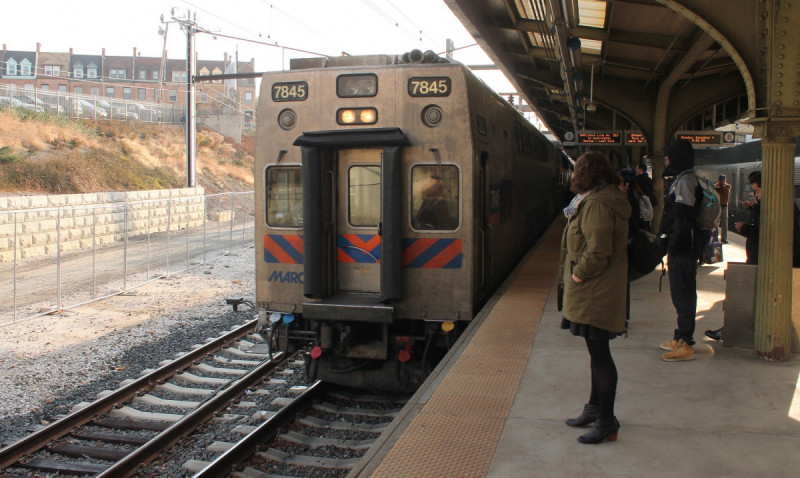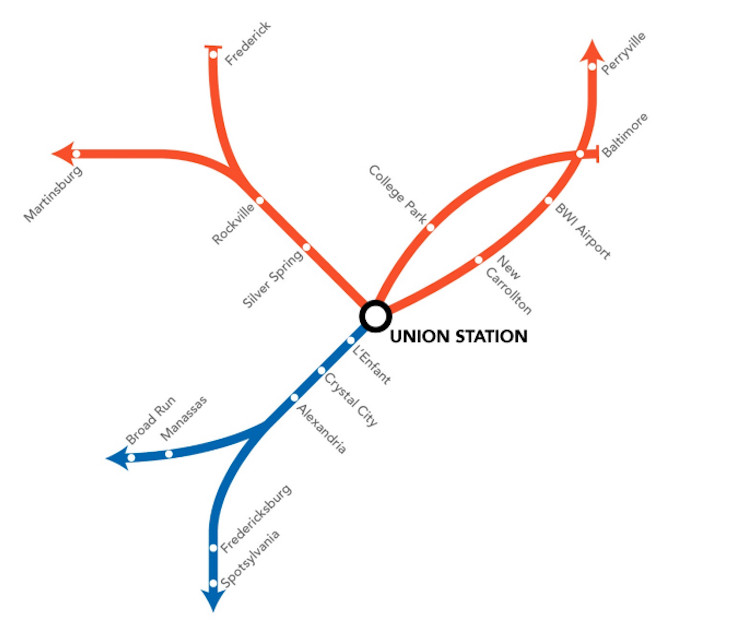A new report strengthens the case for MARC “run-through” service to Virginia

People waiting on MARC train by Elvert Barnes licensed under Creative Commons.
Even with Maryland Governor Larry Hogan’s recent veto of a bill to study expanding MARC (Maryland Area Rail Commuter) service to Northern Virginia, the potential demand to bring “run-though” rail service across the Potomac River remains strong according to a new report presented to the Washington region’s main planning body this week.
The report, written by a Rockville-based transportation planning firm called Foursquare ITP, was commissioned last year by the National Capital Region Transportation Planning Board (TPB), itself an offshoot of the Metropolitan Washington Council of Governments (MWCOG).
The TPB, which dates back to the 1960s, is primarily tasked with drawing up long and short-term regional transportation plans.
But another key part of its mission is to provide technical resources and analysis to its member jurisdictions’ individual transportation issues and projects. And that includes projects like through-running MARC trains into Virginia or VRE trains into Maryland.
The report defines “run-through” service as “a scenario whereby MARC and/or VRE provide service beyond their current terminus of Washington Union Station, and into Virginia or Maryland, respectively.” While the document itself more than 45 pages long, its main conclusions are pretty simple.
An image MARC and VRE rail lines. Image by Foursquare ITP.
First, the report estimates that there are already 13,900-weekday trips per year on MARC or VRE that cross between each railroad’s service area. This includes riders who take MARC from Penn Station in Baltimore to Union Station in Washington, DC, then transfer onto VRE or Metrorail at Union Station and take it to Crystal City. That alone is already good for 27% of each system’s weekday ridership.
The largest potential run-through ridership is easily from people traveling to or from a combination of MARC’s two Baltimore-based branches, the Penn and Camden Lines, and the four stations shared by both VRE’s Fredericksburg Line and its Manassas Line: Alexandria, Crystal City, L’Enfant Plaza, and Union Station. Foursquare’s models estimate a base ridership of 9,900 trips if run-through service was to start today, with 11,600 trips by 2030 and 12,400 trips by 2040.
MARC’s other route, the Brunswick Line, wouldn’t contribute quite as much of the demand for run-through service. Projected base ridership is about 4,300 trips (which the model doesn’t see changing on its own in the next decade). However, that number is expected to jump to 4,700 trips by 2040, and would still provide a fairly respectable amount of the demand for through-running.
While Virginia would obviously benefit from run-through service, with the report projecting a potential 33% increase in ridership at Crystal City by 2030 if through-running is adopted, one of the largest beneficiaries might be DC itself. That’s because Foursquare’s projections suggest through-running could increase ridership by 100% at L’Enfant Plaza by 2030.
Finally, most of the run-through trip production, at least for now, would be generated in Maryland, with the greatest demand between Baltimore and Alexandria. Whether this could change if Maryland steps up its TOD (transit-oriented development) at any of the eight stations on the Penn Line between Baltimore Penn Station and Union Station or any of the eight full-service stations and two flag stops on the Camden Line between Camden and Union Station remains to be seen and was well beyond the scope of Foursquare’s study.
The report also addressed several of the obstacles which so far have thwarted both Maryland and Virginia’s past attempts at exploring through-running. There are several projects scheduled or likely to be scheduled over the course of the next decade which would complicate extending MARC service into Virginia or VRE service into Maryland.
The replacement of the Long Bridge in Washington, Virginia’s Rail Improvement Program, the expansion of Union Station, the rapid aging and potentially lengthy replacement of the B&P (Baltimore and Potomac) Tunnel in Baltimore, to name a few. And that’s without even mentioning the differing platform heights and trains used by MARC’s three lines and VRE’s two lines.
Still, at a time when the arrival of Amazon in Arlington County is expected to increase the already surprisingly high demand for transit service between Central Maryland and Northern Virginia well beyond what any one line in those areas can currently handle, Foursquare’s report for the TPB provides more than enough reason to further investigate through-running, including through legislation like the bill Hogan just vetoed.
